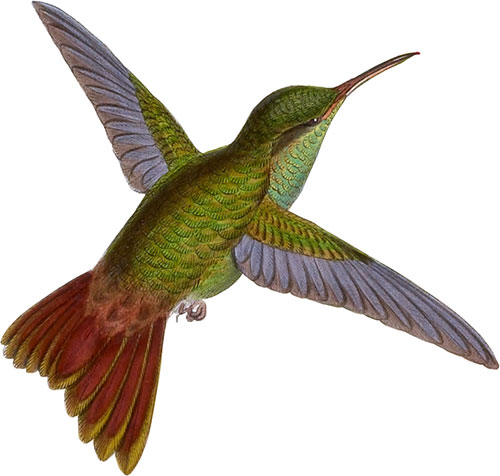I am much indebted to Dr. Cabot, of Boston, North America, for the loan of the type specimen of his Trochilus Yucatanensis, a bird which differs from every other species that has come under my notice.
It is perhaps most nearly allied to the Amazila cerviniventris, but differs in the truncate form of the green colouring of the throat, which in that bird extends down each flank. Dr. Cabot sent at the same time another specimen, which he considered to be the female; and this may possibly be the case; but I suspect that it will prove to be another species, the A. cinnamomea (A. corallirostris of my work). The upper figure in the accompanying plate is an exact representation of this specimen; and it remains for future research to determine whether my surmise be correct or not. In all probability the A. cinnamomea flies in Yucatan, as it is very common in the neighbouring countries of Honduras and Guatemala.
The following is Dr. Cabot’s description and brief account of this species, published in the ‘Proceedings of the Boston Society of Natural History,’ to which, I learn, he has nothing to add; for, in a letter dated April 30, 1859, he says, “It gives me great pleasure to aid you as far as I am able in your most interesting and beautiful work; but I regret exceedingly to say that it is a long time since my observations were made, and that my notes were unfortunately lost overboard while coasting along the shore of Yucatan in a canoe, I regret also that I have no duplicate of the male to present to you.”
Trochilus Yucatanensis. Length 4 inches. Bill \(\frac{6}{8}\) of an inch. First primary longest; primaries curved, broadest at their tips; tail, somewhat forked, rather more than 1 \(\frac{1}{2}\); inch long, consists of ten feathers; bill light yellowish at base and along centre of mandibles, dark horn-colour at tip and halfway along sides; male brilliant shining emerald on chin, throat, and upper part of breast; head, upper part of neck, and back dull golden green with some metallic reflexions; lower part of breast, belly, under tail-coverts, central and upper part of tail-feathers light bay; tips and both sides of central tail-feathers and outer side of lateral tail-feathers dark golden green with metallic reflexions; vent white; female nearly the same as male, but rufous instead of bright emerald on chin, neck, &c., and less white about vent.
This is the most common Humming-Bird found in Yucatan. It was seen in numbers about the acacias which grew upon the tops of the ruined buildings, where the specimens from which the above description was taken were procured.
The figures are of the natural size. The plant is the Passiflora Medusæa.
 Amazilia corallirostris
Coral-billed Amazili
Amazilia corallirostris
Coral-billed Amazili
 Amazilia cerviniventris
Fawn-breasted Amazili
Amazilia cerviniventris
Fawn-breasted Amazili
 Amazilia castaneiventris
Chestnut-bellied Amazili
Amazilia castaneiventris
Chestnut-bellied Amazili
 Amazilia Riefferia
Rieffer’s Amazili
Amazilia Riefferia
Rieffer’s Amazili
 Amazilia beryllina
Berylline Amazili
Amazilia beryllina
Berylline Amazili
 Amazilia Devillei
Deville’s Amazili
Amazilia Devillei
Deville’s Amazili
 Amazilia viridigaster
Green-bellied Amazili
Amazilia viridigaster
Green-bellied Amazili
 Amazilia cyanura
Blue-tailed Amazili
Amazilia cyanura
Blue-tailed Amazili
Featuring all 422 illustrated species from John Gould’s A Monograph of the Trochilidæ, or Family of Humming-Birds arranged by color.